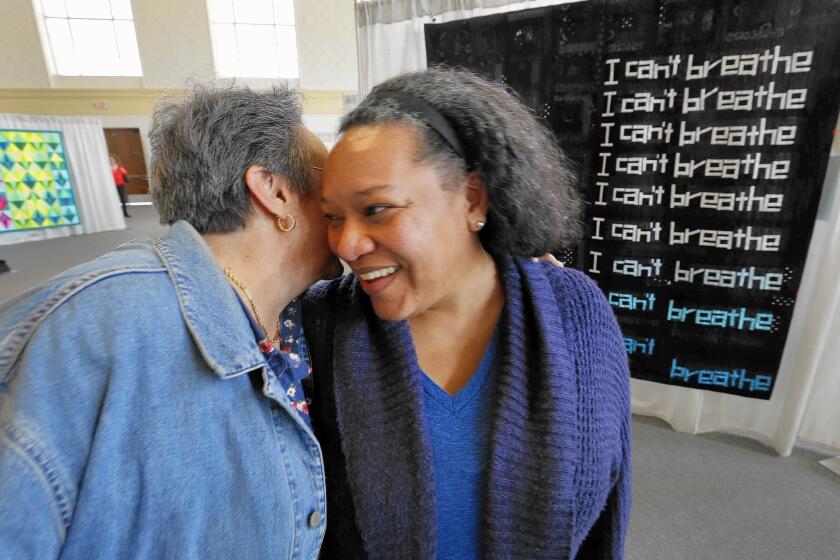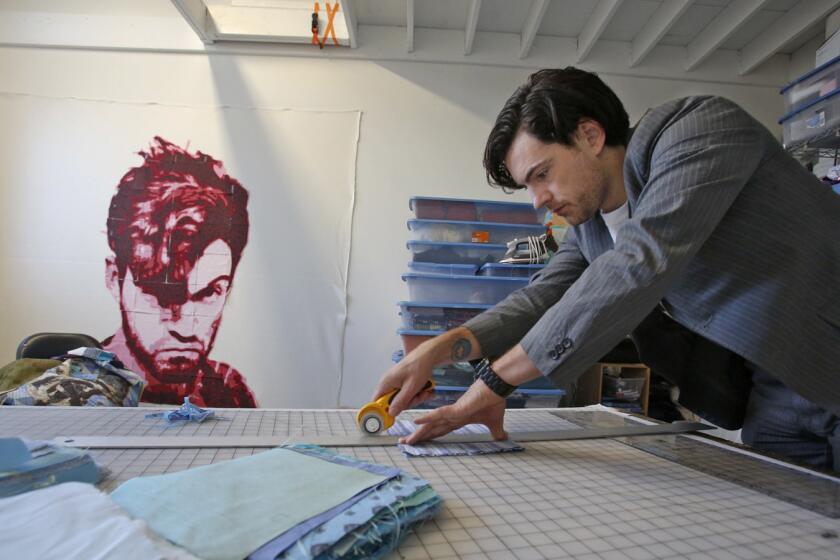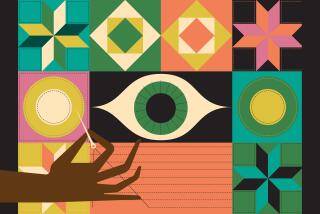Who is American? Skirball exhibition in L.A. answers the question with quilts
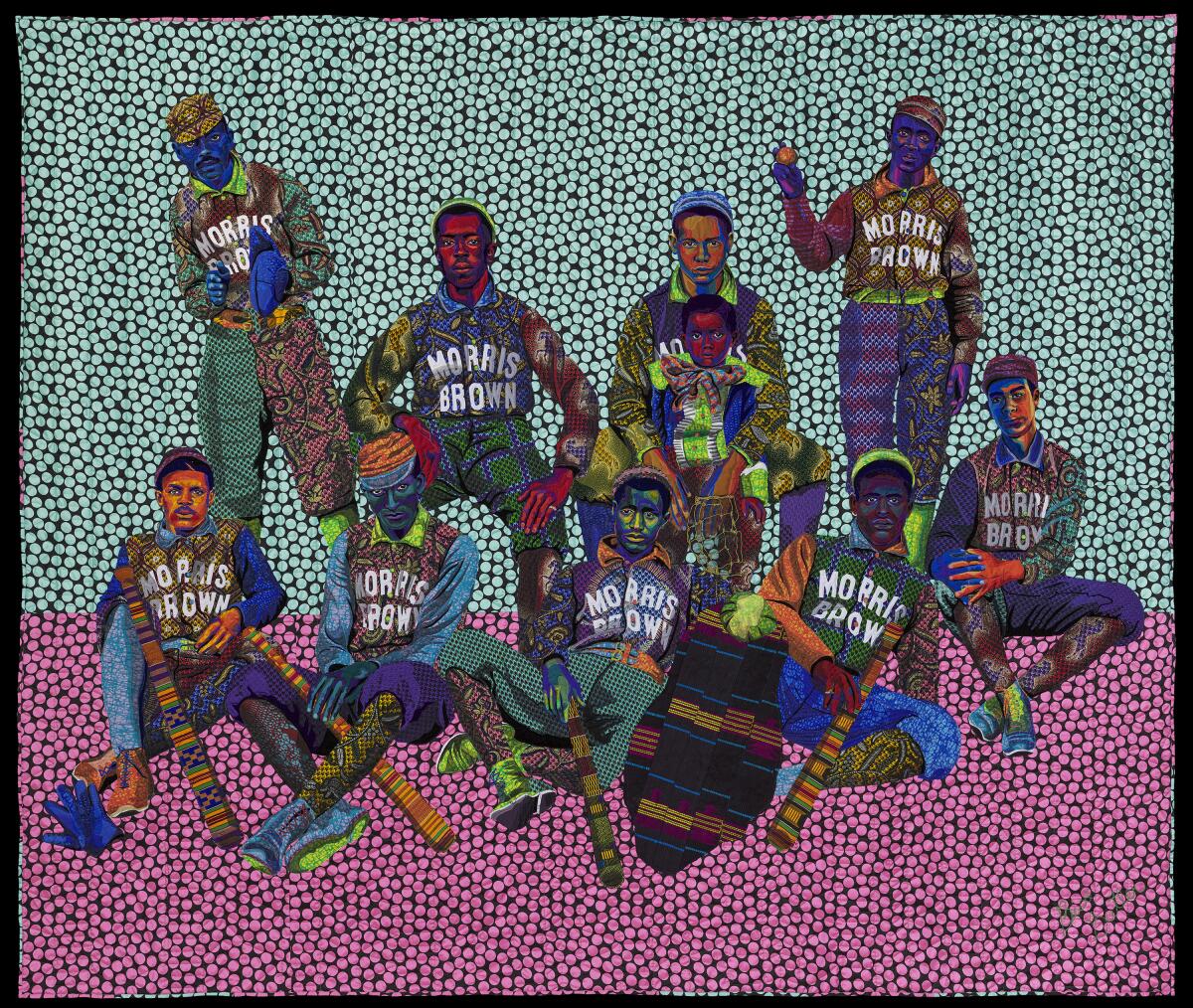
When the exhibition “Fabric of a Nation: American Quilt Stories” debuted at the Museum of Fine Arts Boston a year ago, its mission was clear: “to upend the notion of what a quilt is.”
That’s according to Jennifer Swope, one of the three MFA Boston curators who compiled the 2021 publication upon which the show is based. Beyond celebrating quilts as more than just a utilitarian handicraft or hobbyist fancy, she and her colleagues aimed to address a larger question: “What is the story of America and what parts of it can be told through quilts?”
“Textiles are a very immediate and intimate medium,” Swope said. “I think quilting is an ideal artform to present such a sweeping story.”
She traveled to Los Angeles to prepare the exhibition for its West Coast premiere at the Skirball Cultural Center last Thursday. On view are 37 select pieces from the original show, as well as five additional pieces created by L.A.-area artists.
She found her inspiration in the overnight violence report sent every morning to her husband, a district leader for the Chicago public school system.
While walking through the space during installation, Swope pointed out seemingly simple whole-cloth quilts that spoke volumes about 18th century global trade — from Caribbean-grown indigo to cotton picked in the Deep South and manufactured in British mills to silks imported from Asia. Other pieces evinced highly refined technical prowess, signified elevated social status or illustrated the role quilting played in unifying rural townsfolk. Still others weren’t immediately recognizable as quilts at all, as with Virginia Jacobs’ mammoth, multicolored orb sculpture at the exhibition’s mezzanine entry.
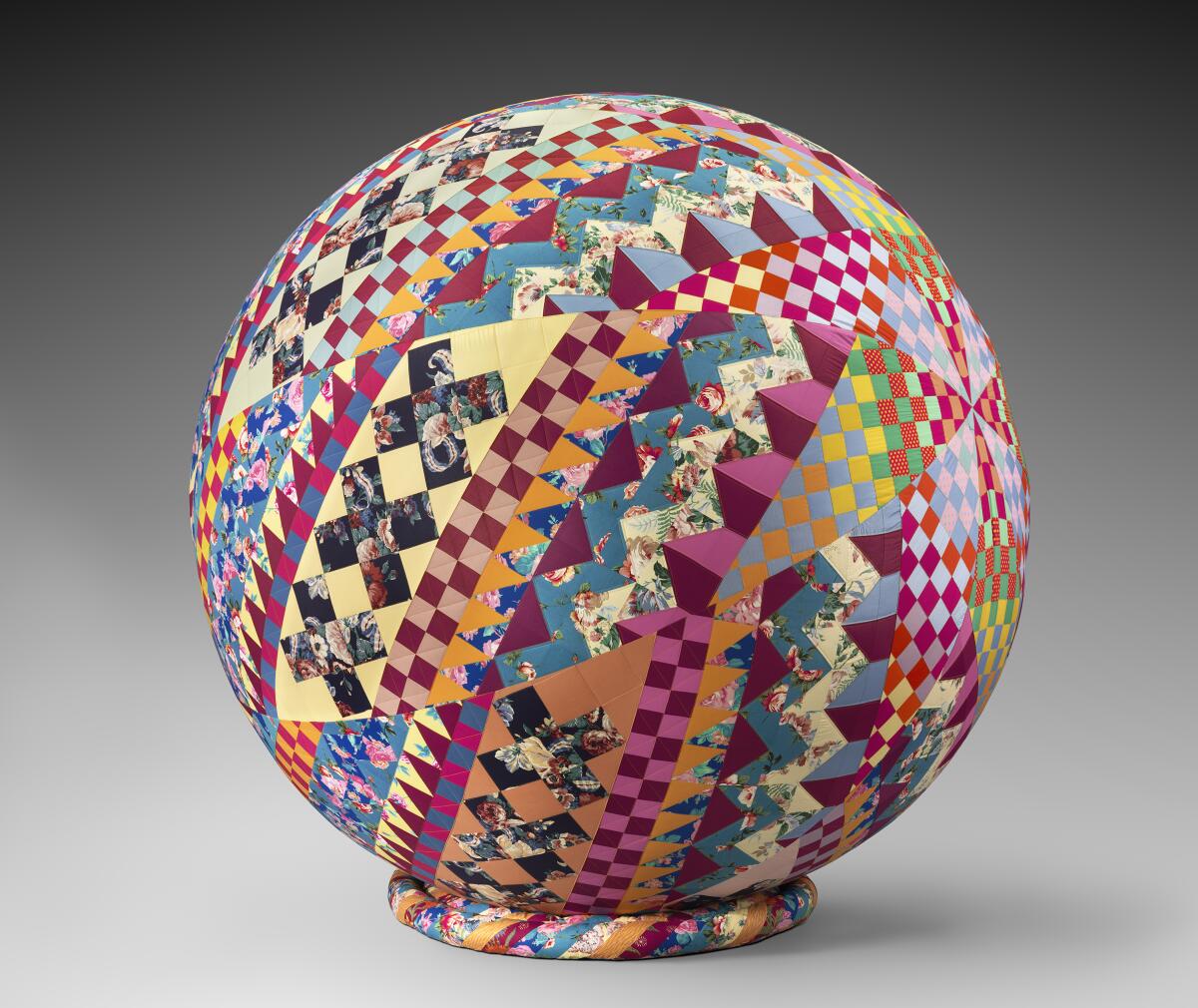
The collection features works that span 300 years and includes pictorial, album and art quilts, as well as functional bedroom coverlets, mixed media and sculpted pieces. Some artifacts memorialize revered statesmen or commemorate historic milestones, while others relay social issues or simply spark joy. United by an invisible thread, they explore themes of identity, place and history.
“What I appreciate about how Jennifer’s laid out this exhibit is that she starts with two questions: ‘Who is American?’ and ‘What is American?’” said Skirball Associate Curator Dani Killam. “Then, throughout the exhibit, you see that these questions can be answered in a multitude of ways as different voices come through.”
“Ellis Island,” a quilt created in 1996 by the Hamish Amish Quilters of Van Nuys, speaks to America’s reputation as a nation of immigrants. Its cluster of photo transfer fabric blocks sheds light on the experiences of many Ashkenazi Jews who landed in the States, with dignified family portraits, bleak snapshots of tenement dwellings and child labor and a newspaper clipping about the Triangle Shirtwaist Factory fire anchored by a central image of the Statue of Liberty.
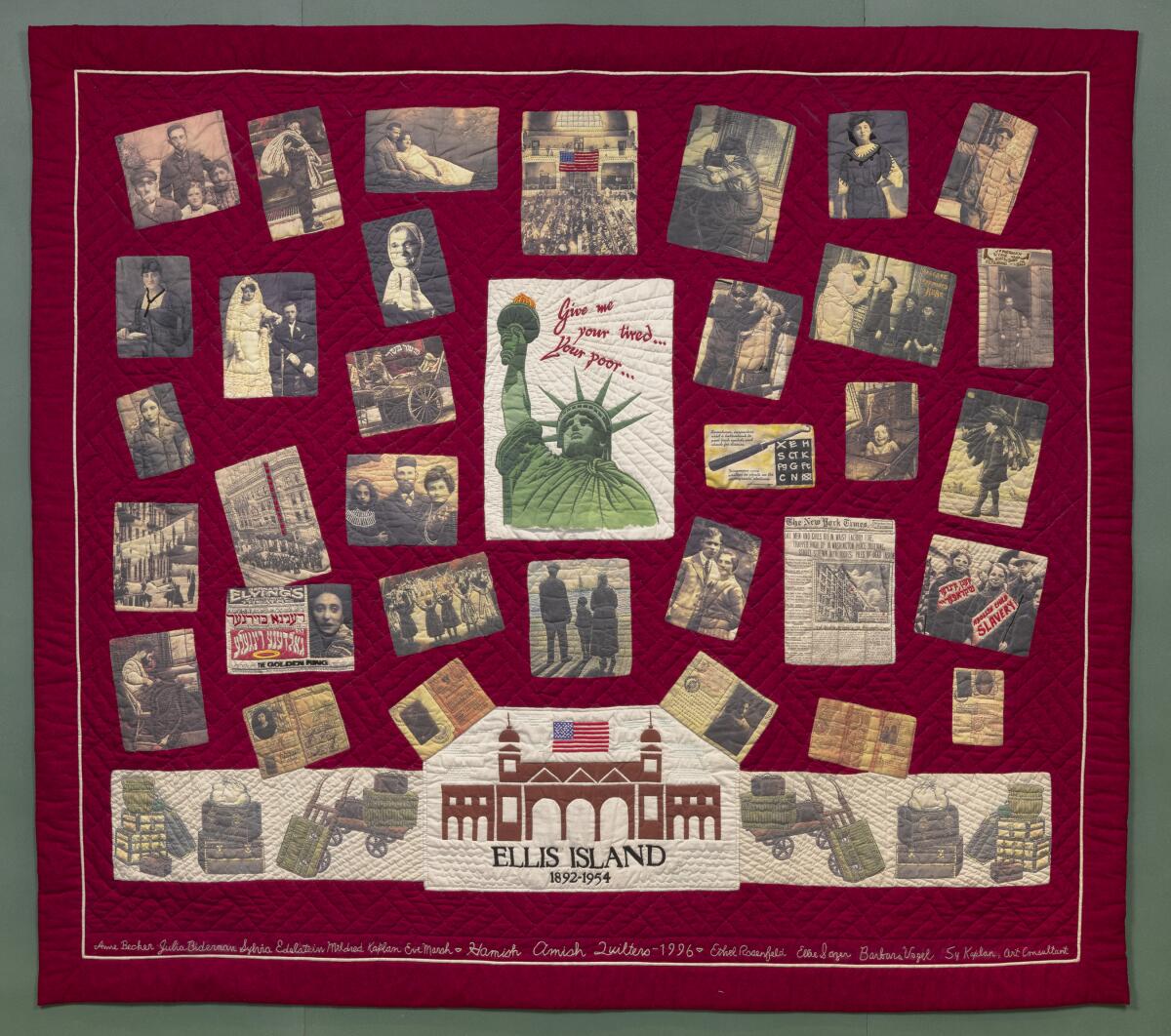
“It’s about bringing forward the unjust nature of the world, but also celebrating the beauty of community as well,” Killam said of the quilt, which is part of the Skirball’s permanent collection.
For his “Ruby Bridges” pictorial quilt, the native Los Angeles artist known as Ramsess selected fabric patterns to evoke the fraught experience of being Black in civil rights-era America. The 2006 piece re-creates the iconic black-and-white photograph of the 6-year-old African American girl who, in 1960, integrated an all-white New Orleans school flanked by federal marshals. Bridges conveys childhood innocence in a cheery, doll-like red dress and yellow cardigan, and the men wear stars and stripes as the trio descends onto a cotton strip that bears a black barbed-wire pattern.
“I used the barbed wire because she was walking a delicate and dangerous line being escorted to school every day,” Ramsess explained of one of his earliest quilted pieces. “The American flags were to indicate that she was and is an American citizen, though a lot of other Americans at the time didn’t believe she had a right to an education.”
The artist, whose practice is based in Leimert Park, also contributed an homage to former Supreme Court Justice Ruth Bader Ginsburg, which will hang in the Skirball’s permanent exhibition gallery, “Visions and Values,” during the run of “Fabric of a Nation.” Moved by a viewing of the 2018 documentary film “RBG,” Ramsess depicted her in cool blue hues, which he thought represented her “calm, yet strong” demeanor. Atop her head, he sewed a crown out of a fabric swatch bearing the image of a geisha as a nod to the Japanese diplomat Chiune Sugihara, who helped Jews flee Europe during World War II.
Throughout the show, quilts by the likes of revered folk artist Harriet Powers and illustrious contemporary textile artist Bisa Butler are interspersed with works made by anonymous Indigenous wool weavers, enslaved domestic servants and working-class seamstresses.
“Often, we don’t know the name of the maker,” Swope said, referencing “countless unknown, underrecognized hands.”
“We wanted to really peel back the layers to look at the circumstances in which they were made and honor the people who contributed to those.”
Los Feliz-based visual artist and filmmaker Sabrina Gschwandtner is similarly driven to champion the overlooked. She weaves together cinematic and fabric-focused practices to honor unsung heroes from both disciplines. Her silent-video quilt “Screen Credit” flashes across the exhibition’s entry, its three wall-mounted monitors presenting an ever-changing digital patchwork of colorful geometric patterns and footage from the independent filmmaker Pat Ferrero, as well as the work of pioneering animator Lotte Reiniger.
Gschwandtner’s “Cinema Sanctuary Study 1” incorporates footage shot by early 20th century Chinese American movie maven Marion E. Wong. The film quilt is composed of black-and-white 35-millimeter strips depicting a bride preparing for a Chinese wedding ceremony, hand-sewn together in a traditional quilt pattern.
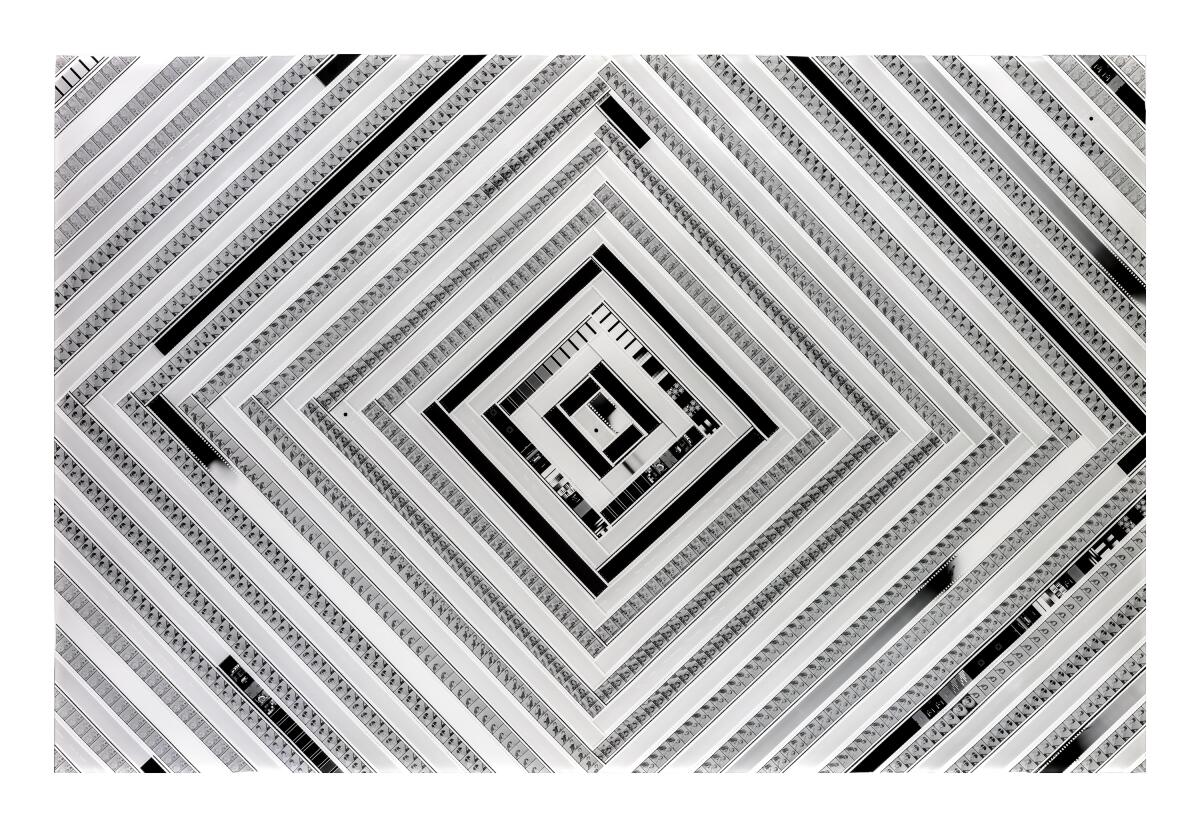
“One of the driving concerns in my work is looking at the ways in which women’s work hasn’t been given its due,” she said, citing an impulse to ensure that “these women are recognized, honored and valued.”
“Fabric of a Nation” also subverts the preconceived notion of quilting as a pointedly gendered practice. There are recent works from L.A.-born conceptual artist Sanford Biggers and basketball player-turned-quilter Michael C. Thorpe, as well as antique pieces made by British and German skilled craftsmen.
Local artist Joel Otterson has created quilts out of concrete and glass in his studio overlooking the L.A. River, inspired by his mother and her circle of church-going quilters. His whimsical 1992 sculpture “Bathtub Chaise Lounge” combines scraps of polyester, wool and French silk velvet with a deconstructed cast iron tub and a cluster of copper and bronze plumbing pipes.
“I’m all about soft and hard — I crochet and I weld and I do everything in between,” he said. “My whole thing has been about masculine and feminine. It’s about me, as a gay man wanting to do ‘ladies’ work’ and being really happy with that.”
For nearly four decades, Otterson’s subject matter has surveyed “the domestic landscape.” In the mid-’80s, he watched many of his friends get sick and die from AIDS and received an HIV diagnosis of his own. These experiences compelled him to create artwork that celebrates both life and the household items that help humans live it.
“I don’t want to make sculpture that stands in the corner,” he said. “I want to make sculpture that’s inserted into our lives and is all about living.”
Fittingly, his chaise sits only a few feet away from the exhibition’s final piece, a digital representation of what both Swope and Killam called “the most famous quilt in the world,” the AIDS Memorial Quilt. Using a touch-screen feature, the interactive kiosk allows users to view each of the nearly 50,000 panels that make up the community folk art project launched by activist Cleve Jones in 1985.
“It was this incredible grassroots movement that was about people coming together and creating something visual,” Swope concluded.
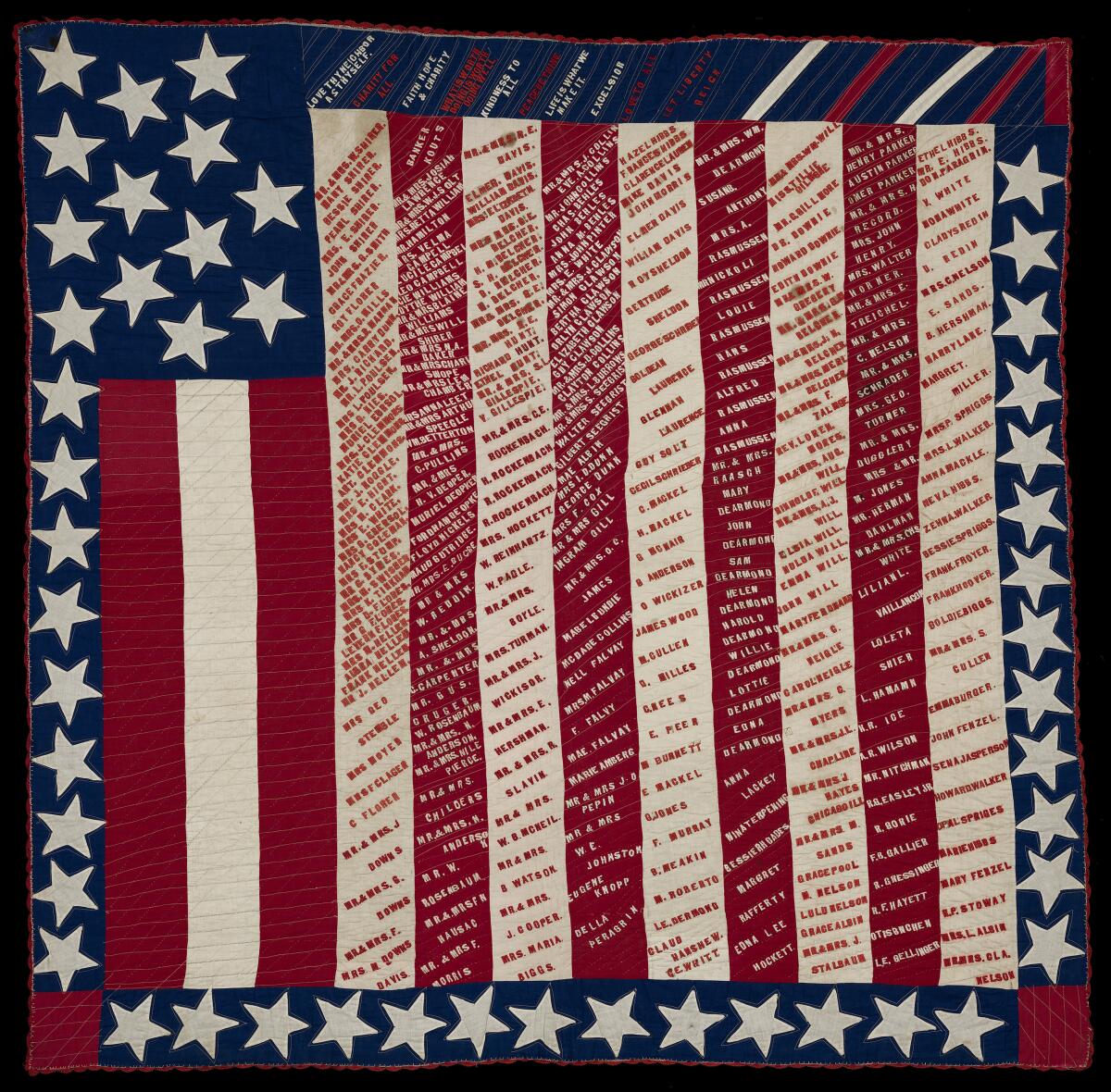
“How would a guy make a quilt?” Joel Otterson asked himself when he began his foray into the craft.
That sentiment is echoed in the Skirball’s companion exhibition “Together for Good: Caron Tabb and the Quilting Corner.” Inside a cozy interactive workshop space, visitors can view and take inspiration from Tabb’s globe-spanning mid-pandemic community quilt titled “Fabric of Humanity — Repairing My World,” then design their own fabric square contributions to an ongoing collaborative quilt project that will be assembled by members of L.A.-area quilting guilds.
The Skirball exhibitions follow a recently closed quilt show at Craft Contemporary — the L.A. institution formerly known as the Craft and Folk Art Museum — as well as an installation of prints by the Gee’s Bend Quiltmakers Collective that opened in September and runs for a year at the Huntington Library, Art Museum, and Botanical Gardens in San Marino.
“It’s a vibrant art form,” Swope said, “that is not quietly going away.”
'Fabric of a Nation: American Quilt Stories'
Where: Skirball Cultural Center, 2701 N. Sepulveda Blvd., L.A.
When: Tuesdays-Sundays, through March 12; check for holiday closures
Admission: This specially ticketed exhibition is $13 to $18, which includes access to general admission areas
Info: (310) 440-4500 or www.skirball.org
More to Read
The biggest entertainment stories
Get our big stories about Hollywood, film, television, music, arts, culture and more right in your inbox as soon as they publish.
You may occasionally receive promotional content from the Los Angeles Times.
